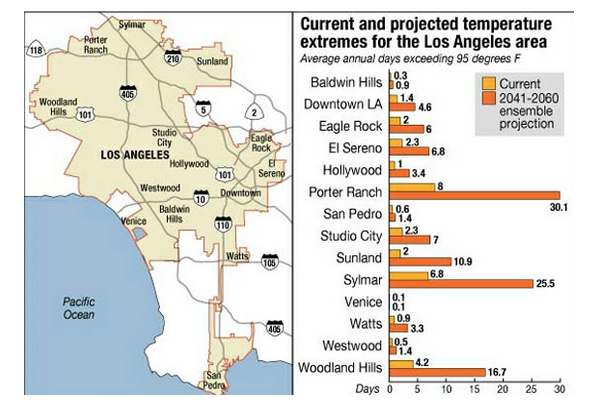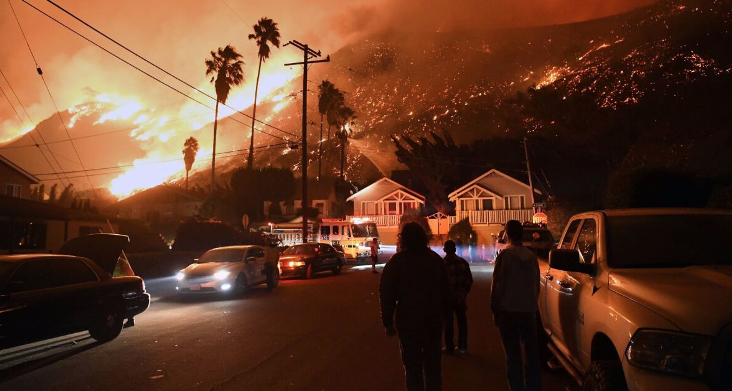CommentsPLANNING WATCH - Most readers assume that the dangers presented by the climate crisis are so compelling that local governments have moved into high gear to eliminate the primary culprit: Greenhouse Gas (GHG) emissions.
Furthermore, the steps to mitigate climate change are widely known, and the City of Los Angeles and METRO could quickly implement them, such as:
- Repairing LA’s decrepit sidewalks so more Angelenos will walk rather than drive to nearby destinations.
- Extensively plant and care for drought tolerant native trees on LA’s parkways, open spaces, and parks, with complimentary trees for underplanted private parcels.
- Shortening bus and subway headways and offering free fares to lure Angelinos out of their cars.
- Retrofitting interconnected buffered bike and scooter lanes into LA’s streets, provided they are not gambits to boost sagging retail corridors.
- Incentivizing roof top solar.
The reasons for taking immediate action are obvious. During the past 140 years, LA’s average temperature has risen five degree Fahrenheit, with more increases on their way. By mid-century, much of Los Angeles will become unlivable unless there are drastic changes to its built environment.

What Los Angeles should do to prevent catastrophe. Unless current trends are miraculously averted, the combination of heatwaves, mega-droughts, super-storms, and sea level rise are baked into our future.
There is no shortage of bad news like this because the one constant at LA’s City Hall is “Build, baby, build!” The climate consequences of this real estate fixation have barely grabbed the attention of LA’s decision makers. Their prime directive is still “growth,” which they misconstrue as the construction of expensive apartment buildings, buttressed by LAPD deployments when demonstrations and homeless encampments disturb this business model.
But there is some good news, a new report from Strategic Actions for a Just Economy (SAJE), authored by Chelsea Kirk: Los Angeles Building Decarbonization: Tenant Impacts and Recommendations. In this study, the author identified a wide-range of building enhancements that could equitably reduce Greenhouse Gas emissions in Los Angeles.
The decarbonization (i.e., reductions of Greenhouse Gas emissions) of new and existing buildings offers a second route to mitigate the major cause of climate change. In Los Angeles, 43 percent of these emissions come from buildings, and Mayor Garcetti’s Green New Deal proposes decarbonizing new buildings by 2030 and older buildings by 2050. Unfortunately, LA’s Green New Deal is a short-lived executive document, without a budget, implementing ordinances, and an adequate monitoring program.
The decarbonization of LA’s buildings – up to $28,000 per unit -- costs far more than most tenants can afford. According to the SAJE report:
“Two-thirds of all rental units in Los Angeles are owned by corporate investment entities as Limited Liability Corporations and Trusts. In LA the largest buildings are also the worst emitters. Buildings 20,000 square feet or larger represent 2 percent of the building stock but account for 29 percent of Greenhouse Gas emissions. Furthermore, trusts and corporations own 98 percent of buildings with 50 or more units. These trusts and corporations have much deeper pockets than tenants and mom-and-pop landlords to cover the costs of rehabbing older buildings to bring them up to new low-carbon codes.”
The report also identified specific building upgrades that could mitigate Greenhouse Gas emissions:
- Energy efficient electric appliances and new electric panels.
- Improved heating and cooling.
- Exterior painting.
- Landscaping and tree planting.
- Flooring, fixtures, doors, and windows.
- Rooftop solar.
According to SAJE, the decarbonization of LA’s buildings could proceed without displacement if City Hall protected tenants and subsidized non-corporate building owners for their decarbonization efforts.
Separate from SAJE’s recommendations, City Hall must also prepare a General Plan Climate Change Element that proposes decarbonation roles for specific City Departments (e.g., LADWP, LADBS, HCID), linked to a comprehensive monitoring program that would determine which programs work and which should be scrapped or replaced.
These are not easy tasks, and the new City of Los Angeles Climate Emergency Mobilization Office (CEMO) will soon host community assemblies to identify technical and regulatory approaches for decarbonizing LA’s buildings. To assist this process, a recent City Council Motion for Building Justice through Decarbonization has identified critical issues for the assemblies to consider. For this approach to succeed, LA’s rapidly adopted 2021-2029 Housing Element must be amended to promote decarbonization, in lieu of its tight focus on new, expensive, energy-intensive apartments.
Two barriers stand in the way of successful building decarbonization efforts.
The first barrier is the private companies that would benefit from decarbonization efforts, such as contractors and electric appliance vendors. They will heavily lobby for these new programs as a corporate profit center, not as essentials to mitigate the climate crisis.
The second barrier is that building decarbonation barely registers at City Hall, which has few active programs to decarbonize LA’s building stock. This, too, must quickly change, even if it means repealing zone changes designed to promote private investment in upscale, car-oriented, energy-intensive apartment buildings.
(Dick Platkin is a former Los Angeles city planner who reports on local planning issues for CityWatchLA. He serves on the board of United Neighborhoods for Los Angeles (UN4LA) and co-chairs the Greater Fairfax Residents Association. Previous Planning Watch columns are available at the CityWatchLA archives. Please send questions and corrections to [email protected].)












